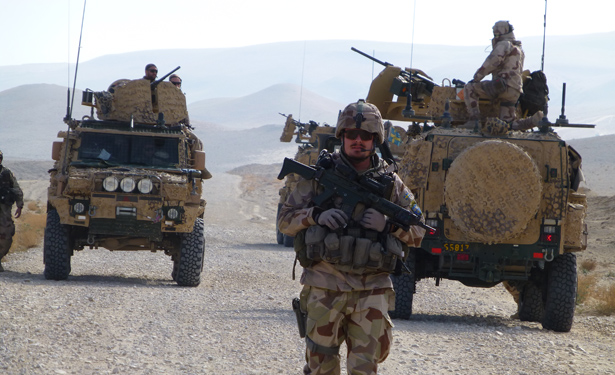The New War for Afghanistan’s Untapped Oil


I am looking out the window as men in grey turbans run from my building out onto the highway, their AK 47s at the ready. “There’s been an accident,” my Afghan guide, Danish calmly tells me. “Someone was just killed in the plaza here.”
I am in Faryab province in northwest Afghanistan, which had been considered among the more peaceful areas. “Was someone hit by a car?” I ask. Danish pauses. The “Oh yes, she’s American” look passes quickly over his face before he replies, “Somebody was shot.”
Within a few minutes we get a report from the secretary of Abdullah Masoumi, the governor of Khoja Sabz Posh District, in whose office we’ve been waiting for some time. It was the Taliban, he tells us, and the victim was Commander Czhulam, a leading member of the governor’s security team and a former commander under General Abdul Rashid Dostum, one of the country’s most powerful warlords.
With the close of 2012, the Pentagon has revealed a disturbing trend in Afghanistan: Taliban attacks remained steady, or in some cases increased, over 2011 levels. I experienced the Taliban surge firsthand this past November, and can offer a cause not cited in the Pentagon’s report: oil and gas.
I was there as part of a three-week investigation into the growing efforts of both the US and Afghan governments to develop Afghanistan’s oil and gas sector. I prepared my itinerary to include what are supposed to be among the safest regions, and was traveling alone with just a local guide and driver, my only “safety-gear” the local clothing and black head covering I wore. As long as I kept my mouth shut, with my dark hair and Middle-European heritage, I regularly passed for a local. I was tracking an oil and gas trail across Western and Northern Afghanistan. But so too, it became increasingly apparent, are the Taliban.
I was to interview Governor Masoumi because his district sits atop fields of natural gas in one of the most energy-rich provinces. As in virtually all of Afghanistan, none of the fields are marked because almost no natural gas or oil operations are taking place. I know the fields are there because I am following a map of Afghanistan’s oil and natural gas riches produced by the United States’ Government’s US Geological Survey (USGS).

Abandoned Russian oil derrick in village in Ahmad-a-Bad District, Herat Province, Afghanistan. (Photo: Antonia Juhasz)
My journey has uncovered a largely hidden battle being waged for control of Afghanistan’s fossil fuel resources. The Afghan and US governments hope these resources will attract international oil companies and raise badly needed income. The Taliban appear increasingly bent on denying the fruits of the sector to their rivals, be they local, national, or international.
As we leave Faryab, Danish warns, “If the Taliban catch us, throw your camera out the window and pretend to be my deaf mute mother.”
Two days later I’m in Jowzan province to the north of Faryab, waiting at the gates of the Khoja Gogardak natural gas treatment plant, a few miles from Sheberghan city. A lone guard sits nearby. Old, thin, and short with a small grey turban and stark white beard, his AK-47 is casually slung across his shoulder while two small “guard puppy” dogs relax at his feet, enjoying the calm afternoon sun in the heart of General Dostum’s territory. His lackadaisical attitude is both quaint and oddly reassuring.
Suddenly, Mir Hasan, head engineer of the facility, appears and ushers us quickly inside. “There is a recent security situation which is not good and the military will be here in a few minutes,” Danish translates.
Hasan had received word a few minutes earlier that his employees working at a natural gas field behind the facility and just in the distance (he points, we look) were attacked by the Taliban. “Right here?!” I ask. “Yes,” Danish confirms. Hasan politely reassures me that he is happy to give me the tour of the facility, 90 percent of which is outdoors and in full view of the just-attacked field, but we’ll have to be quick about it as the Afghan military is on its way. “This just happened?!” I ask. “Yes, exactly,” Hasan responds. “Has this happened before?” I ask. “Mostly their attacks take place during the night,” he explains. “This is the first time that they have attacked during the day.”
I quickly recall that on the road out of Mazar-i-Sharif, the city General Dostum calls home, Danish had been shocked to see a man on a motorbike brazenly wearing the telltale-black turban of a Taliban and brandishing his weapon in the middle of the day. It was the first time either Danish or our driver had seen such a display in over ten years.
“I think we better go,” Danish tells me. I try to stall, hoping to be there when the Afghan military arrive, but the men are anxious. Engineer Hasan cannot yet report any details other than that when the Taliban began shooting, his men got into their vehicles and fled the area without apparent injury. “You are not very lucky,” Hasan tells me, as we say goodbye to him at the gate.
How right he was. I am standing in the middle of the street in Sheberghan City waiting for Mohammad Chaari, commander of security for the Amu Darya oil contract area awarded in 2011 to the China National Petroleum Corporation (CNPC) in partnership with Afghanistan’s Watan Group. With two facilities operating in Sari Pul Province south of Jowzan and east of Faryab, theirs is the only oil production in Afghanistan — although they currently ship their entire product to Turkmenistan. Almost a week earlier, I had been given a secret tour. (The Chinese no longer allow press onto the facility, so I was snuck in.)

Faiz Mohammad (former Sheberghan gas worker) and Danish (guide) speak with Mir Hasan, head engineer, Khoja Gogardak natural gas treatment plant, Sheberghan city, Jowzan Province, Afghanistan. (Photo: Antonia Juhasz)
While we wait for Chaari, we overhear a conversation between him and two CNPC engineers from Sari Pul. There has been a Taliban attack near the facility, “large enough to call in air support.” No one would say more when asked, but Commander Chaari does tell me that his security detail are about to be significantly increased.
We begin crossing oil and gas fields off my itinerary, deeming them too “insecure” to visit, including oil fields very near to the city of Mazar-i-Sharif and the entire province of Kunduz. “Insecure,” I have quickly learned, is code for “Taliban.” As the director general of the Afghan Oil and Gas Survey tells me, “There is nothing else causing insecurity.”
The US Pentagon is the de-facto lead US agency pushing the development of Afghanistan’s oil and gas sector. Jim Bowen, a Houston oilman hired by the Pentagon to guide a November 15 international oil and gas contract tender process, confirmed for me that these attacks are in fact on the rise. “Certainly, as the [oil and gas] sector develops, the sector is creating targets, there is no doubt about that,” Bowen tells me. “But exactly how one defines ‘Taliban’ is open to interpretation.”
Sitting in Kabul shortly before my departure, I speak with Javed Noorani, extractive industries monitor for the Afghan NGO Integrity Watch. He confirms Bowen’s analysis: As the oil and gas sector draws increasing public attention, so too have Taliban attacks grown. But identifying who is supporting those Taliban, “be they Pakistani, Iranian, or homegrown, is not so simple.”
The result is clear, and far from unique to Afghanistan: As development of the oil and gas sector has risen, so too has violence and insecurity.
